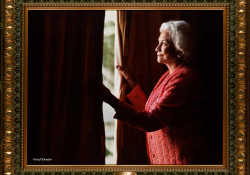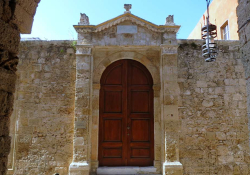Directing By the Bog of Cats
Scenes from Marina Carr’s By the Bog of Cats, directed by Susan Shaughnessy
University of Oklahoma
March 10–14, 2012
Photos: Ty Johnson / The Oklahoma Daily
Marina Carr’s 1998 play, By the Bog of Cats, was the third collaboration between World Literature Today and the Peggy Dow Helmrich School of Drama under my direction. The play was produced in celebration of the Puterbaugh Festival in honor of the 2012 Puterbaugh fellow, Irish playwright Marina Carr. Carr was in attendance at the opening night of the play (March 10, 2012), which closed the festival.
It was a pleasure last spring to be consulted by RC Davis-Undiano, Daniel Simon, and World Literature Today in the selection of the Puterbaugh fellow. In a world generally thought to be largely dominated by men, many talented women have taken their places in the theater; playwrights such as Caryl Churchill, Judith Thompson, Wendy Wasserstein, and Mary Zimmerman, to name but a few. I had included Carr’s early work in a seminar on international women writing plays, which I taught several years ago. I have been aware of her steady development and rise in recognition over the years. In fact, her new play, Phaedra Backwards, premiered last fall at the McCarter Theatre in Princeton, New Jersey, under the direction of Emily Mann. Once it was determined that Marina Carr would indeed be the 2012 Puterbaugh fellow, my director’s work began in earnest.
My first task was to decide upon the play that would be produced, which entailed reading both volumes of her published work, subsequent articles, and reviews of productions of those plays. What drew me first to By the Bog of Cats were the extraordinary characters who populate the play. Upon first reading, one might think that this play is an example of classic rural Irish drama, like Brian Friel’s Dancing at Lughnasa. Further readings and analysis, however, reveal a universe that straddles the natural and the supernatural and explores a woman’s deep tie to the land of which she is a part. (I was reminded of Hester Swane when I saw the New York production of Jez Butterworth’s Jerusalem last summer.) Hester is an unmarried mother of seven-year-old Josie and an Irish “traveller,” or “tinker,” as she is referred to by many of the characters in the play, marginalized by both stations. She struggles to be allowed to remain in her world, haunted by the desertion of her mother when she was seven years old, and vowing to remain in the bog to await her return.
Inhabitants of the Bog of Cats include the blind Catwoman, who prophetically and firmly urges Hester to leave before disaster strikes, a feline Tiresias. Hester’s nemeses, the Kilbrides and the Cassidys, doggedly attempt to eject her from the world she knows. We meet the inhabitants of other worlds in the characters of the Ghost Fancier and the Ghost of Joseph Swane, Hester’s murdered brother. Gentle Monica Murray, perhaps Hester’s only ally, young Dunne, a waiter, and the unusual flirtation between the ancient Father Willow and Catwoman provide fodder for a hilarious second act that goes seriously wrong by its end.
Another aspect of Carr’s writing that attracted me to the script was her ability to join the world of rural Ireland to Greek mythology. She sees in the frozen bog of winter a setting in which a parallel to the Medea myth can be realized. Carthage Kilbride, Hester’s lover and the father of young Josie, is determined to leave Hester and marry the oddly delicate Caroline Cassidy. Hester, in spite of the humiliation of the situation, is determined to retain her place in the Bog of Cats, hold on to her daughter, and wait for her mother’s return. The results of her determination are tragic, resulting in the death of her daughter and herself by her own hand, much like Medea’s end with Jason as she kills her own sons. The play places the audience on an emotional pendulum, exploring the gamut of human response.
I was much aided in my research and analysis, as well as staging, by my dramaturg and assistant director, Kasey Sams. Ideas began to crystallize once designers were in place, and I had the good fortune to work once again with my emeritus colleagues, Jerry Lewis as lighting designer and Mike Buchwald as costume designer. Student designer Chris Fitzer accepted the task of creating the scenic elements for the frozen Bog of Cats, his capstone project. During ongoing research and exploration, discussion began among the team. I had decided that the dual nature of the universe of the play, the extraordinary characters, and the way in which we are drawn into a world beyond the real would be best served by combining visual elements. Thus, the set became more abstract and evocative, and the costumes more realistic. Lighting would play an important role in terms of mood and tone, isolation of location and special demands, for instance a fire! Chris provided images of frozen bogs, and we were particularly drawn to an image of a frosty willow tree. This became the main scenic element, becoming the location of Hester’s caravan. All seating was natural, emerging from the bog itself, except for the very real outdoor table and chairs for the scenes in the first act between Josie and her crass grandmother, Mrs. McBride. Those disappeared for the rest of the play, a large linen-covered wedding table carried on for the second act, and the bog on its own for the third. The colors that emerged as central to the set design were white, black, and red. Frost-covered willow tendrils hung as characters, particularly Hester and the Ghost of Joseph Swane, killed by Hester herself, made their ghostly way among them. The tree and its tendrils not only provided for interesting staging choices, but also gave Jerry a “canvas” upon which to work his lighting magic.
Next came auditions for the play. As many of you know, it is often said that casting is 85–90 percent of a director’s job, and I am among those who believe it. Obviously, key to the success of the play was casting the role of Hester Swane, as she is in just about every scene in the play and the story revolves around her. I had worked with Anna Fearheiley on Dacia Maraini’s play Mary Stuart, also sponsored by World Literature Today, and was familiar with her talent and work ethic. By the time callbacks were over, I felt very certain that she would be an excellent Hester. I was confident in the casting of the other roles as well, from the quirky Chandler Ryan as Catwoman to the irascible Xavier Cassidy (Philip Wiles) to the sweet, gentle Ghost of Joseph Swane played by Tyler Brodess. I can say, which is not always the case, that this entire cast of fifteen was spot-on and worked as a solid ensemble, supportive of one another through the entire process. Six weeks of rehearsal later, the company played a five-night run, enjoying full houses and standing ovations at every performance. Thank you, Marina, for a terrific play.
In conclusion, I must comment on the interdisciplinary process with World Literature Today. Being somewhat of a hybrid production, By the Bog of Cats was not a University Theatre production, and therefore supported differently from the usual university productions. Professional designers and technical support had to be hired, and this was possible only through this collaborative sponsorship. But, perhaps more importantly, this effort was such an inspirational one. Students who were not cast, people who had no course credit or financial gain to expect, were there simply for the experience of being involved in this production process and to participate in the Puterbaugh Festival. And work hard they did. I also believe that we reached many community members not only from the university family, but the Norman high school students and the community at large. Audience members also included members of the roundtable discussions from around the country and, of course, our 2012 Puterbaugh fellow. It was my privilege to lead the production of Marina Carr’s By the Bog of Cats for the conclusion of the 2012 Puterbaugh Festival.
University of Oklahoma
















